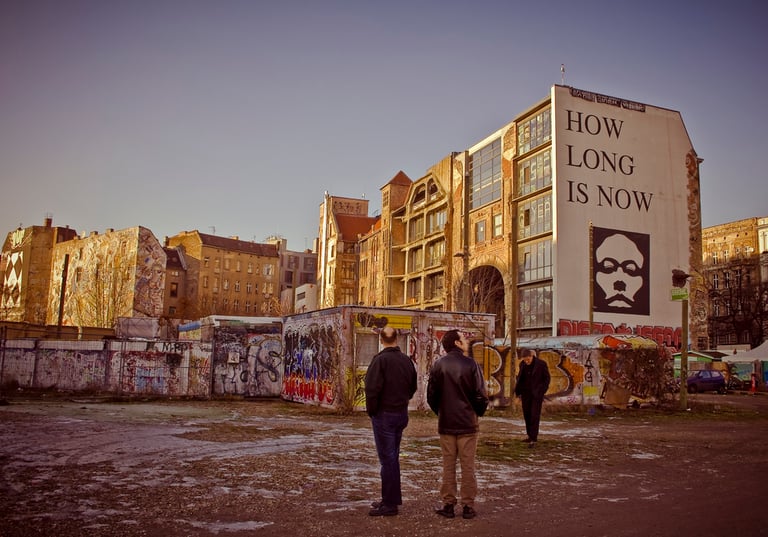Berlin’s Tacheles: Art Gets the Wrecking Ball
Evan Moffitt
1/16/2013


It smelled of dust, mold, and spray-paint. The porticos were illuminated in red, green, and violet light that leaked out onto the street. Through a towering stone archway, one could see fires blazing in oil drums, placed in muddy walkways between straw huts and tents where beer and maté tea were served.
This was the scene that greeted visitors to Tacheles, the countercultural hotbed of art and politics in Berlin. Before World War II, Tacheles was a fashionable Jewish-owned department store in Mitte, the city’s center. After the beginning of World War II, it was appropriated by the Gestapo and used as a prison before sustaining heavy damage from Allied bombing. Half of the building was demolished, and the hulking grey mass on Oranienstrasse lay smoldering deep within the borders of East Germany until the fall of the Berlin Wall. It was then that Berlin’s infamous squatting community gave it a new life.
Occupied by artists who previously had no working space, Tacheles became a beacon of free expression and a symbol of the libertine culture in the early 1990’s that invaded East Berlin like a tidal wave. Artists and musicians who had been repressed by the “Stasi” secret police for decades were finally free to create boldly and freely. Students who had grown up under the GDR dictatorship took to the streets—and the burgeoning nightclub scene—with revolutionary passion, and found in Tacheles a free public canvas for their ideas. “Tacheles” in Yiddish means “straight-talk”. As a name, it recalls the honesty of the building’s former occupants, who at last felt free to speak their minds.
Squatting in Berlin isn’t just an act of economic desperation; it is considered by many Germans to be a form of political protest. Throughout the 1970’s, many students squatted in historic buildings and helped prevent their premature demolition. Even last month, a group of senior citizens in the suburb of Pankow successfully saved a community center by camping out in its game room. In Tacheles’ case, a community of artists cum squatters chose the site as their rent-free gallery, where they could host discussions and performances. Nightly parties were held in a beer garden, set up in the vacant lot behind the ruined structure. By the century’s end, a skeleton of the Second World War had become a captivatingly diverse community of artists and international transients that attracted visitors from around the globe.
Many visitors were surprised to find that a place like Tacheles could exist in the center of a Western European capitol, just steps away from Berlin Cathedral and the seat of German government. Urban development in Berlin has never been static, but as the city recovers from decades of destruction and division, it is falling prey to gentrification. Tacheles is the most visible victim of the city’s sea change. Tacheles’ resident artists had been threatened for years by prospecting entrepreneurs eager to snatch the precious property in central Mitte. In 2011, the building’s owner, HSH Nordbank, scheduled a demolition that was never carried out. Last August, the Berlin Police constructed barricades of scrap metal in the main entryway, preventing access to the upstairs galleries or the beer garden. By September 4th, the building’s last fifty occupants left peaceably.
It is unknown when Nordbank will fully demolish Tacheles, but in several years time the site will house a new luxury hotel. Berliners hope that Tacheles’ death is no augur of the change to come, but gentrification here seems imminent. It has left Berlin artists asking one question, painted in red on a forlorn paper-maiche gorilla perched above the entrance to the condemned landmark: “Where will we go now??”
